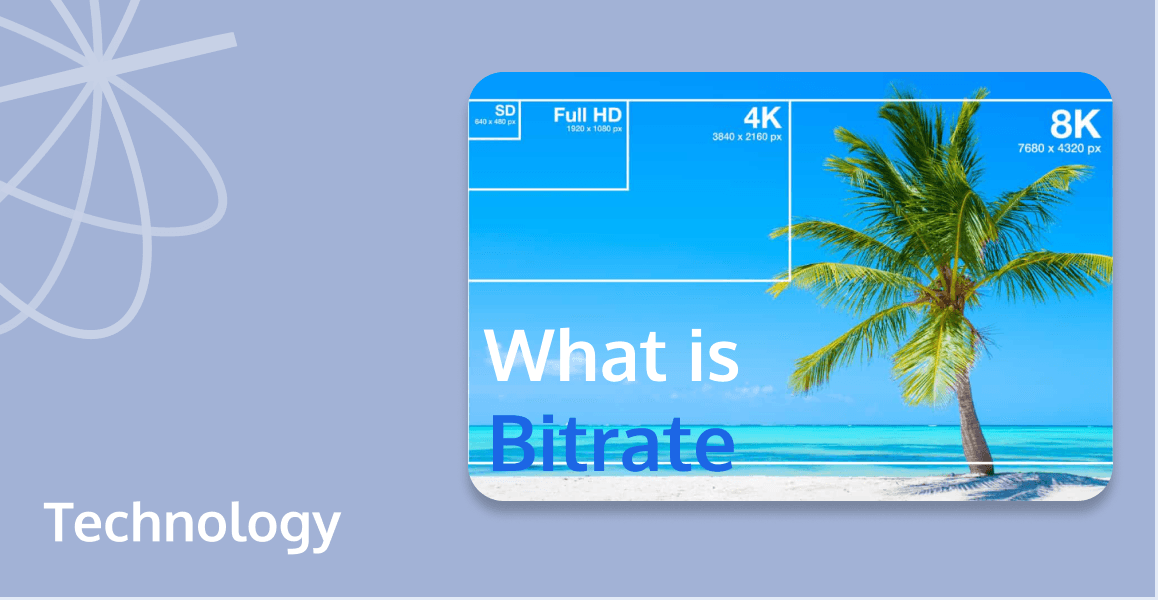
If you're into digital media, even if you're just starting or a pro, it's essential to know what is bitrate. This article breaks down why bitrate matters, what affects it, how to measure it, and how to tweak it to make your audio or video just right. Whether you're streaming, making a podcast, or working on a video, understanding bitrate helps you get the quality and performance you need!
What Is Bitrate
Bitrate, measured in bits per second (bps) or kilobits per second (kbps), represents the number of bits processed per unit of time. It quantifies how much data is being transferred from one place to another within a set timeframe. In the context of video and audio streaming, bitrate directly influences quality, as it represents the number of bits that are transmitted from the source to the viewer every second. The higher the bitrate, the more data is sent, resulting in better potential image and sound quality. However, it also necessitates more bandwidth and results in larger file sizes, which can impact streaming dependability and storage.
Importance of Bitrate
Understanding the importance of bitrate is crucial for optimizing both the quality and efficiency of multimedia content.
- Quality of Streaming: Bitrate immensely impacts the level of detail and clarity in your video and audio streams. In this context, quality corresponds directly with bitrate: a higher bitrate yields a higher-quality stream, whereas a lower bitrate can lead to quality degradation and poor video output. Therefore, it's essential to consider the overall quality of your stream and user engagement.
- File Size: Bitrate also influences the size of your audio and video files. A higher bitrate means a larger file size, and lower bitrate results in a smaller file size. This is particularly important when streaming with limited bandwidth or storage capacity, as balancing your bitrate can ensure a good-quality stream without surpassing your available resources.

Factors That Affecting Bitrate
Here are some of the main factors that affect the bitrate:
1.Bandwidth
Bandwidth pertains to the data transfer capacity of a network. If the bandwidth is limited, you may need to lower your Bitrate to prevent buffering issues. Higher-quality streams, which require a higher bitrate, also need more bandwidth, highlighting the interrelation between these factors.
2.Resolution
Both video bitrate and resolution work in conjunction to provide the best streaming quality possible. Greater resolutions usually require a higher bitrate to maintain quality, positing that adjusting one may necessitate an adjustment in the other.
3.File Format and Codec
The codec used and the file format are also significant to consider in terms of bitrate. For instance, higher bitrates might be required to maintain superior video quality when implementing a lossy codec, as it eliminates some data to achieve a smaller file size. Conversely, a lossless codec, which removes no data, might not need such a high video bitrate. Note that, some formats are more efficient than others, enabling the same quality at a lower bitrate.
How to Set Bitrate
Setting the optimal bitrate for streaming or recording video and audio balances quality and practical bandwidth utilization. Here's a step-by-step guide on how to adjust the bitrate for the best quality and efficiency:
- Assess Your Bandwidth: Check your internet connection's upload speed using an online speed test. Your chosen bitrate should be around 50-75% of your available upload speed to account for fluctuations without causing buffering.
- Understand Your Content: Different types of content may require different bitrates. For example, fast-paced action content may require a higher bitrate compared to talking head videos to maintain clarity.
- Select a Resolution and Frame Rate: The resolution and frame rate of your video will determine the baseline for your bitrate setting. Higher resolutions and rates necessitate higher bitrates. For instance, streaming in 1080p at 30 frames per second (fps) typically requires a higher bitrate than streaming at 720p at 30fps.
- Consider Your Audience: If your audience has varying internet speeds, choose a bitrate that accommodates the lowest common denominator to ensure a steady viewing experience for most viewers.
- Use a Bitrate Calculator: Use online tools like Bitrate Calculator for guidance. Input details like video resolution, frame rate, and internet speed. Then, it will suggest an optimal bitrate.
- Encoding Settings: Decide between Constant Bitrate (CBR) or Variable Bitrate (VBR). CBR is reliable for maintaining a consistent quality, while VBR can adjust to complex scenes, but it can be less predictable for streaming.
- Test the Stream: Once you've set your bitrate, test your stream. Look for buffering, quality issues, and file size to ensure that it is both high quality and seamlessly delivered.
- Adjust as Necessary: Adjust the bitrate accordingly if you notice quality issues or buffering. If you have a higher bandwidth availability, experiment with increasing the bitrate to improve quality. If you are constrained by bandwidth, reduce the bitrate but monitor for loss of quality.
- Utilize Adaptive Bitrate Streaming (ABR): If possible, enable ABR to dynamically adjust the bitrate in real-time depending on the viewer's bandwidth, providing the best possible quality for each user.
Pro Tip: Using advanced RTC solutions like Tencent RTC, leveraging built-in features such as adaptive bitrate streaming is a breeze and can significantly enhance the viewer's experience, ensuring content delivery is optimized for each user's bandwidth. This integration not only simplifies the process of managing streaming quality but also elevates the overall quality of video and voice calls. With its global deployment optimization and high compatibility across various devices and platforms, Tencent RTC is designed to deliver clear and reliable interactive experiences for a wide range of applications, from social entertainment to educational and healthcare services, making it an ideal platform for creators aiming to enhance or expand their streaming and video content offerings.
Conclusion
To wrap up, understanding bitrate is key for anyone into digital media. It helps you find the right mix of quality and size for your audio and video files. By fully comprehending what is bitrate, you can make your media look and sound great, without wasting space. So, what are you waiting for? Go ahead and elevate your digital media projects today!
FAQ
Here are some commonly asked questions about what is bitrate.
How can I determine the optimal bitrate settings for my media files?
To determine the optimal bitrate settings for your media files, consider the target platform and audience's internet connection. Use media analysis tools or consult platform-specific guidelines to balance quality and accessibility, ensuring a smooth playback experience without unnecessary buffering.
Are there any disadvantages or limitations to using high bitrate settings?
Using high bitrate settings can lead to increased file sizes, which may result in longer download or buffering times for your audience, especially those with slower internet connections. Also, it might lead to higher storage and bandwidth costs on the hosting side.
How does bitrate compression affect file size and storage requirements?
Bitrate compression reduces the file size, making media files easier to store and distribute. However, it's a balancing act; too much compression can degrade the quality of the media, affecting the visual or auditory experience. Choosing the right level of compression is key to maintaining quality while optimizing for storage and bandwidth efficiency.
If you have any questions or need assistance, our support team is always ready to help. Please feel free to Contact Us or join us on Discord and Telegram.


